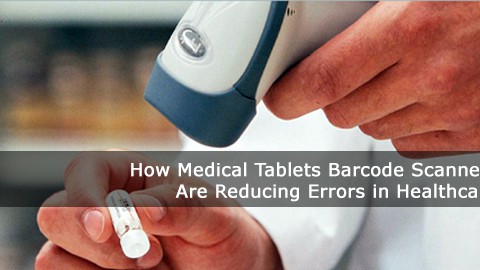Businesses constantly seek to increase their productivity, accuracy, and customer satisfaction. And it’s just not businesses: non-profits like healthcare organizations are also on the lookout to deliver the best patient care.
Barcode technology is helping both sectors accomplish their goals, whether streamlining inventory management or simplifying logistics. In today’s article, we go into depth on how the technology works, the different kinds involved, how it’s used today, and what to look for when checking out barcode readers and scanners for your purposes.
The Many Barcode Scanner Options
Article Guide
A barcode scanner or reader is a device that reads barcodes, those familiar parallel black and white lines found on many products today. Those lines translate into characters with typical barcodes containing between 20-25 characters. The characters usually represent the item’s name, SKU number, and manufacturer.
Barcode readers use various technologies to perform their scans and come in many types and models. Some of the more popular or well-known ones include:
Laser scanners, which use lasers as the light source when scanning barcodes.
CCD readers use sensors to measure the light coming from the barcode instead of self-reflected light hitting it from a laser.
Camera-based barcode scanners take a photo of the barcode to read it. These scanners are primarily used to read 2D barcodes, such as QR codes.
In addition to different technologies used, barcode scanners are also deployed in other configurations. Handheld barcode readers like scanner guns are portable devices held in the user’s hand. They read barcodes by being pointed directly at the barcode. Fixed-position barcode readers are stationary, with items passing underneath them to be scanned. Many are simply handheld barcode readers locked into place by a stand. Finally, presentation scanners are flat surfaces that read barcodes swiped across their surfaces.
Significant Benefits of Barcode Scanners
The barcode was developed in 1949, with the scanner following in 1971. From retail to healthcare, numerous human endeavors have benefited from barcode scanning technology. Some of the benefits include:
Greater accuracy with fewer errors: The manual entry of product information is fraught with human error. Scanning barcodes, on the other hand, results in far fewer opportunities for mistakes. It should be noted errors in the barcodes themselves are extremely rare.
Real-time data: Barcode scanners update their linked databases each time a barcode is read. Companies now have constant, real-time information on their inventory and sales, making it easy to calculate vital metrics like the value of inventory on hand or the week’s point-of-sales (POS) per item.
Less training: Companies in the past had to train new employees on their inventory and sales methods, a time-consuming process. Barcode scanners practically eliminate this need for memorization and training. Even the latest employee becomes quickly efficient and productive thanks to a barcode scanner’s ease of use.
Easier inventory management: Companies find it easier to manage inventory thanks to the real-time data provided by barcode scanning (“inventory scanning”). Management can range from reducing excessive spending on products to cutting down inventory carrying costs and obsolete inventory.
Low cost of entry: Barcode technology, from the barcode printers to the scanners, is inexpensive compared to similar technologies like RFID scanning. Setup can be as simple as a designated smartphone with scanning software and a limited number of barcodes for internal use.
Uses of Barcode Scanners Across Many Industries
As previously mentioned, barcode scanners have found many uses in numerous industries. Four notable such uses:
Shipping/Receiving: With inventory scanning, companies can track their packages at each stage of the delivery process: when leaving their facilities, en route via delivery service, and acceptance by the customer.
Specimen Collection: Barcodes ensure patient information accuracy as their blood and other specimens are sent to labs for processing and the results are uploaded for providers’ review.
Medication Administration: Barcodes on the patients’ wristbands contain medication information, their name, and their primary physician. Staff can bring the information on their EMR via a quick swipe of their medical tablet and its built-in barcode reader. The process ensures that the right patients are getting the correct medication and dosage.
Work in Process (WIP): Manufacturers can use barcode scanners to track every piece of raw material used in their products (WIP). The information gathered can be used in various ways, from finding product defects to keeping costs down.
Choose the Suitable Barcode Scanner for You
Selecting a suitable barcode scanner for one’s company can be daunting, given the number of applications and models. You can narrow down your search by considering factors such as:
Scanning technology: Barcode readers use lasers, light, or cameras when scanning, each having advantages and disadvantages. Discuss them with barcode scanner vendors to see which works best for your company’s uses.
Scanning range: Will the reader be inches away from the barcode? Or further? And is there the possibility of obstacles in the way like dust? These and more can affect the abilities of the reader.
Connectivity: How will you transfer information between the barcode scanner and its database? While some readers plug into industrial computers via USB-C cables, others use Wi-Fi. Both have advantages and disadvantages.
Durability: Where and how the barcode scanner is used can affect its longevity. For example, handheld scanners for warehouse use must be durable enough to withstand being dropped and banged against objects. Presentation scanners like the ones used at most grocery stores will not need to be so ruggedly built.
Cost: What is your budget? While handheld scanners can vary between $50 to $500 per unit, larger or more complex ones, like grocery store presentation scanners, can cost thousands.
Fulfill All Your Barcode Scanner Needs with Cybernet
Barcode technology, composed of inexpensive labels and readers, provides a simple and highly accurate way to collect information ranging from products to personal data (e.g., patient information, driver’s licenses, etc.). Many scanning technologies and equipment have been developed to meet the various sectors’ unique wants and needs.
Looking for ways to use barcode scanning to optimize your business practices? Contact the team at Cybernet Manufacturing. Many of our products already have built-in barcode scanners, making them ready to get to work as soon as they’re powered up. Our computers and tablets have been specially built for various industries and their unique conditions, and we can provide even greater customization as an Original Design Manufacturer.
Join the conversation and connect with us on this and other relevant topics – Follow us on Facebook, Twitter, and LinkedIn.
How Medical Tablets Barcode Scanners Are Reducing Errors in Healthcare
December 3, 2015
Technology is dramatically changing health care as we know it. Patient care is improving. The speed in which medical decisions are being made about a patient’s care is quicker than ever. Electronic medical record (EMR)…
0 Comments4 Minutes
How RFID and Barcode Scanners are Reducing Production Errors
November 24, 2021
Wouldn’t it be great if no one made errors? Unfortunately, that’s not the world we live in. Errors in production from not enough raw material to miscounting shipping containers can impact a business’s bottom…
0 Comments10 Minutes
You Can't
Learn from a Pop-up
But we can deliver knowledge to your inbox!
We dive deep in the industry looking for new trends, technology, news, and updates. We're happy to share them with you.
Knowledge, News, and Industry Updates Right in Your Inbox




